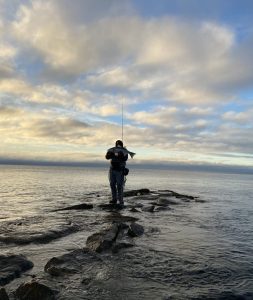Surfcasting during the Northeast mullet run can be an exhilarating experience. On a blustery morning along Nantucket Sound, a strong southwest wind churned the water, creating ideal conditions for targeting striped bass. Pencil poppers sailed through the air, and on the second cast, a school of small, silvery baitfish leapt from the waves—mullet had arrived. As the water erupted around the lure, aggressive stripers attacked, creating an exciting topwater bite that continued for nearly a week.
Topwater lures such as pencil poppers, bottleneck poppers, minnow plugs, and soft-plastic paddletail swimbaits are highly effective when stripers key in on mullet. Though the mullet run has become less consistent over the years, it still creates a feeding frenzy that surfcasters eagerly anticipate each fall.
The Northeast Mullet Run
Striped mullet, globally distributed between latitudes 42 degrees north and 42 degrees south, are a primary baitfish for striped bass during the Northeast fall run. In this region, mullet usually range from 4 to 6 inches, though occasionally larger specimens, known as “corn cobs,” are encountered. These fish spawn offshore during the winter months, then return to brackish waters in the spring. By fall, they begin migrating back to offshore waters, triggering aggressive feeding from gamefish.
Recent sightings suggest a range of mullet sizes in the Northeast, with an average of 3 to 5 inches and some larger fish mixed in. In areas like Cape Cod, mullet runs are short but intense, drawing in schoolie stripers and over-slot fish as they migrate south.
Timing the Mullet Run
Timing the mullet run can be tricky. Anglers in Rhode Island report seeing mullet as early as August, with runs peaking between mid-September and early October. However, the strength of the run can vary dramatically from year to year. Dennis Zambrotta, a Rhode Island surfcaster, notes that factors such as tropical storms can disrupt the run, while calmer surf conditions improve the chances of spotting mullet.
In Long Island, the mullet run typically occurs later in the season, with stripers feeding on 4- to 5-inch mullet around inlets in late September. The run often lasts until early October, though some years, larger mullet make a brief appearance later in the month. John Papciak, a Montauk-based surfcaster, highlights that mullet runs are fleeting, unlike the more sustained sand-eel bite. Once mullet leave an inlet, the action can be over in a week.

The Impact of Weather
Weather plays a crucial role in determining the success of a mullet run. Low barometric pressure, coupled with dropping air and water temperatures, can trigger mullet to leave the bays and head offshore. The first nor’easter of the season often signals the start of the mullet run, especially in areas like Montauk. Rough water conditions can increase the likelihood of a strong bite, particularly when mullet are moving along beaches and jetties, where predators like striped bass and bluefish lie in wait.
Regional Mullet Run Patterns
In northern New Jersey, mullet typically arrive in late September or early October, just before peanut bunker start to appear. Mike Gleason, co-owner of TAK Waterman in Long Branch, observes that the mullet run sets the stage for the fall migration. The largest waves of mullet usually show up between the second and third week of September, with 3- to 5-inch mullet being the most common size.
Nick Honachefsky, a New Jersey surfcaster and TV host, agrees that the mullet run marks the beginning of the fall run, with schools exiting the backwaters as soon as water temperatures drop into the 60s. While the mullet run has diminished in recent years, it still offers prime fishing opportunities for stripers and bluefish when the conditions align.
Finding Mullet
Identifying the right locations is key to successfully intercepting mullet. Surfcasters recommend targeting areas where mullet are forced to cross open water, making them vulnerable to predators. In Long Island, mullet move westward along the beaches, so positioning ahead of a school of mullet can yield better results than chasing them down the shore.
Fishing around inlets and jetties is another effective strategy, as these structures often trap mullet, creating ideal ambush points for gamefish. Additionally, mullet tend to stay in shallow water, close to the beach or structure, where they feel safer from predators.
The Northeast mullet run may be brief and unpredictable, but for dedicated surfcasters, it offers some of the most exciting fishing of the fall. From Rhode Island to New Jersey, anglers keep a close eye on the forecast and water conditions, knowing that the arrival of mullet signals the start of the striper migration. For those willing to brave the elements, the rewards can be well worth the effort. Just remember, the mullet run moves fast—don’t miss the opportunity to get in on the action.
Image/Source: OnTheWater





